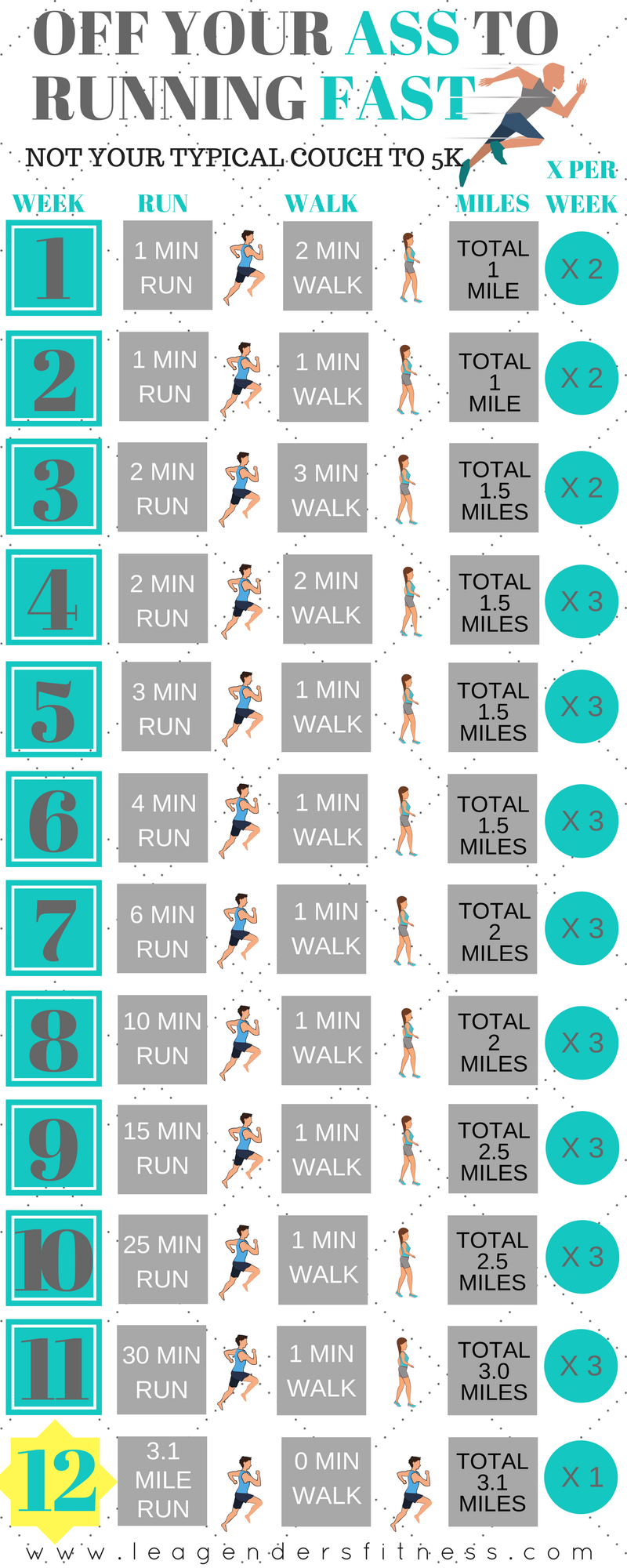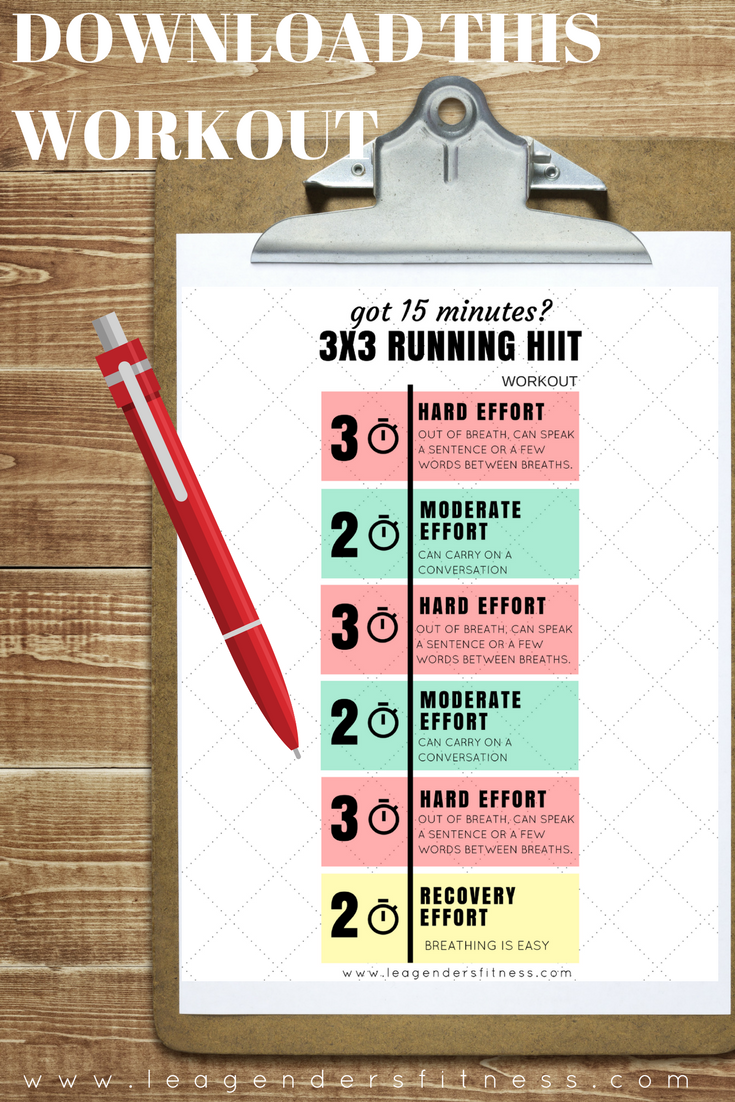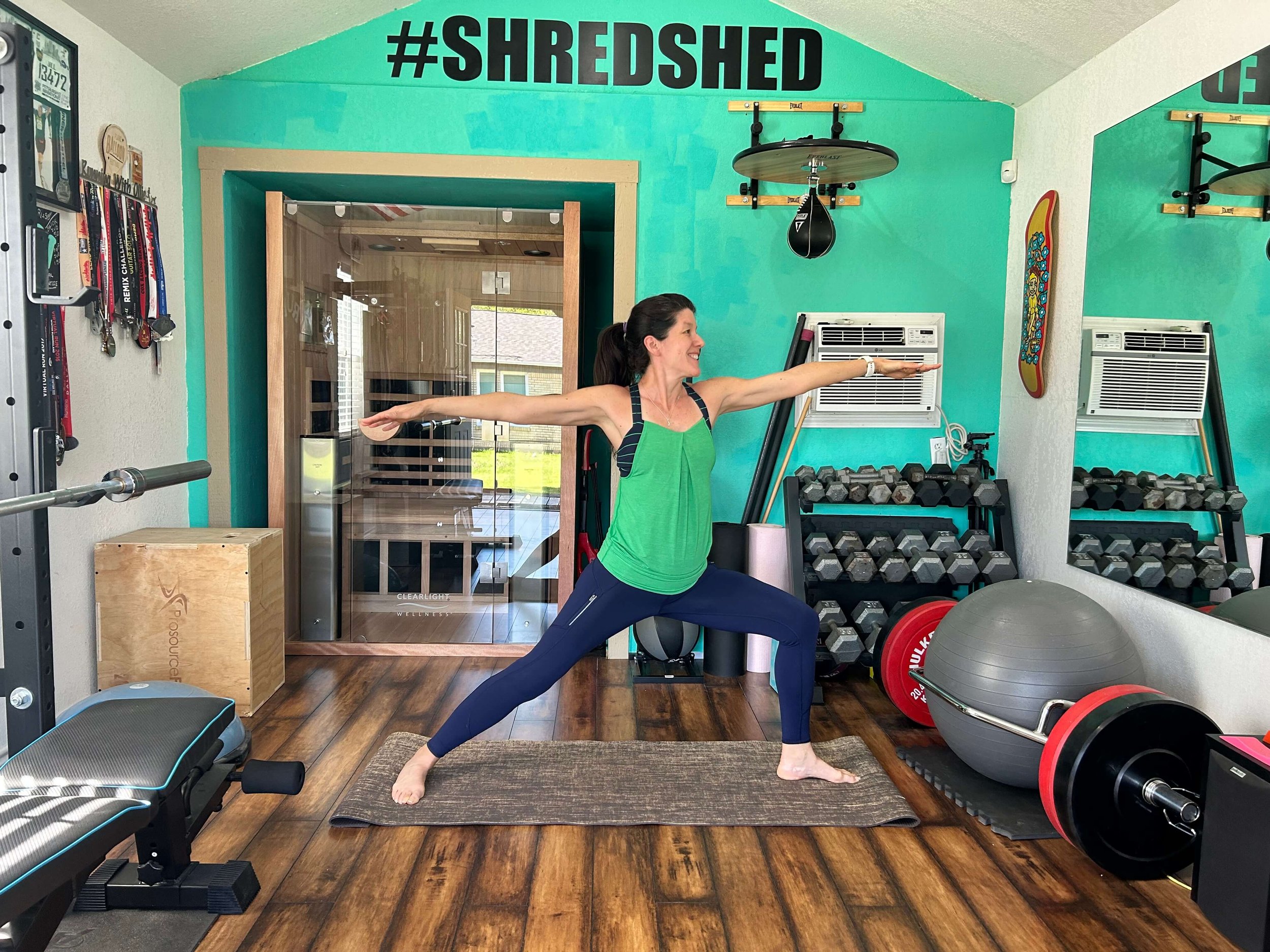Try this tabata-style four-minute workout for when you don't have time to run. It's a quick and efficient way to build strength, speed, and anaerobic capacity.
4-3-2-1 COUNTDOWN INTERVAL RUNNING WORKOUT
Welcome to the latest edition of workout wednesday when each week I share a new running or strength training workout. This week we are talking about running intervals. If you are trying to improve speed and efficiency for your runs, then speed intervals are your new best friend.
Interval workouts are appropriate for runners with a solid running base (consistent three to four easy runs a week for four to six weeks).
This workout is based on feel, so throw your GPS watch in the trash (ok, that thing is expensive, don't do that) or just turn off the settings so your pace doesn't show on the screen. This isn't about matching a certain pace, it's all about effort.
Hard effort means you are breathing heavily and could not hold a conversation without taking gasps of breath between sentences or words if you tried to talk to your running partner. (my running partner doesn't talk back.) It should be challenging, but not so challenging that you can't hold the pace for four minutes. In other words, don't attempt an all-out sprint on your first hard effort interval. In the world of hard effort intervals four minutes can feel like an eternity. Pace yourself appropriately. It probably will take some experimenting to the find the proper pace, run as fast as you can while still maintaining the pace for up to four minutes.
During your recovery intervals either slow to a jog or a walk to catch your breath.
This workout can done in under 20 minutes. I suggest a dynamic warm up before any running workout and then jog for a few minutes before heading into your first interval.
This is a great workout for a treadmill or with a timer on the street or track.
4-3-2-1 COUNTDOWN INTERVALS RUNNING WORKOUT
warmup
4 minutes hard effort
2 minutes recovery effort
3 minutes hard effort
2 minutes recovery effort
2 minutes hard effort
1 minute recovery effort
1 minute hard effort
1 minute recovery effort
cool down
4-3-2-1 countdown interval running workout. save to Pinterest for later.
Cool down with a jog or walk until your heart rate returns to normal. Most athletes only need to perform high intensity workouts like this once or twice a week. Always allow at least 48 hours between hard workouts and get adequate rest and recovery. Adaptation (getting faster or stronger) happens during the rest after the workout, not during the workout itself. If you don't allow your body the proper time to recover and rebuild you will never see the full benefit of your hard work.
Try this workout and let me know how it goes in the comments or on Instagram or Twitter.
Like this post? Can you think of one person who may benefit from this workout? It helps me grow when you share with your friends and followers.
Learn to Run Hills to Build Strength & Speed
If you have been running for awhile and ready to take it to the next level, incorporating hill running into your training plan you can help you break through running plateaus to get faster and stronger.
Hill running recruits more muscle fibers, helps improve speed, builds runner-specific strength and power and can be easier on the joints that flat road running.
I recommend hill repeats for beginner and intermediate runners who have established a solid running base of at least three times a week for six weeks.
Add in hill repeats into your training schedule one day a week to start, after four to six weeks of hill training, you may be ready to add in a second day of hills. I recommend 24-48 hours of rest after hard workouts.
HILL REPEATS
The best way to incorporate hill running into your training is to find a hill outdoors and run repeats. Sometimes the instructions I see online for running hill repeats look too technical and confusing. They sometimes will tell you to find s 7-10% grade hill and run at a 10K pace. Let me help you simplify it.
Find a low traffic hill that looks relatively steep to the eye, one that takes approximately one minute to run from the bottom to the top.
Always warm up before intense workouts.
RUNNING FORM FOR HILL TRAINING
Running hills can help promote a more economical running form.
1. Imagine that there is a rope tied to your waist pulling you towards the top of the hill.
2. Keep your chest up with your shoulders back and down.
3. Keep your neck neutral with your eyes looking forward, not at the ground.
4. Keep your hands loose. Imagine holding a potato chip between your thumb and pointer finger if you have a tendency to clench your fists.
5. Keep your jaw loose.
6. Pump your arms at a 90-degree angle and do not allow them to cross over the front of your body.
7. Keep your elbows close to your body, do not allow them to flare out to the sides.
RUNNING PACE FOR HILL TRAINING
When running hills start at the bottom at a relaxed pace and gradually increase speed as you approach the crest of the hill. If you are new to running hills then it may be enough to simply jog up the hill, you will notice an increase in intensity as compared to running on flat roads. You can work to increase the pace as you improve and get stronger.
RECOVERY BETWEEN REPS
Recover fully between reps, this may mean to jog or walk back down the hill to allow your heart rate to return to normal before you start your next hill repetition. It may take you one minute to reach the top of the hill and two and a half minutes to walk back down to the bottom.
REPETITIONS
Start with three to five repetitions and increase over time as you adapt to your training.
PROGRESSION
It's important to think about how you can progress your training when you're ready. Your body adapts to the workouts you do, so what once felt difficult can start to feel easy and become less effective over time. Once you are running hills on a regular basis, think how you can progress your training to the next level every four to six weeks. A few ways you can progress hill training:
1. Increase the number of repeats. If you were running three repetitions, try to run five or six repeats, build up to 10 overtime.
2. Increase the speed of each repetition. Try to beat your time from the bottom to the top of the hill. Never attempt to increase both numbers of repetitions and speed in the same workout. Increase one at a time to help reduce the chance of injury.
3. Reduce rest time between repetitions. If you were walking between reps, try a slow jog.
4. Find a steeper or long hill to run.
5. Increase the number of days of hills repeats in your training schedule. Start with one day and progress to two days after four to six weeks.
As you get stronger look for ways to keep challenging yourself or you could hit a plateau in your training. It is important not to push progression beyond your current fitness levels to avoid the risk of injury, overtraining, and burnout. For best results, start slow and progress over time, changing variables every four to six weeks.
RECOVERY
Listen to your body and always allow proper recovery between workouts. Your body adapts (grows stronger and faster) during the rest period after the workout, not during the workout itself. If you don't allow proper time for recovery between workouts, you will not see the full benefit of your hard work. I recommend 24 to 48 hours of rest or easy days after hard workouts. Always allow at least one full rest day a week and listen to your body, take more if you need it. Sleep is also an important component to recovery. Aim for 7-8 hours of sleep per night for best recovery and performance benefits.
Are you ready to tackle those hills? It's the workout that runners love to hate, but is so effective in taking your running performance to the next level. Need more help?
Like this post? It helps me when you share with your friends and followers.
OFF YOUR ASS TO RUNNING FAST: NOT YOUR TYPICAL COUCH TO 5K TRAINING PLAN
I feel kind of bad for the guy who originally coined the phrase 'Couch to 5K.' I'm sure it's a running coach somewhere that is not raking the big bucks because he coined the most popular phrase used in every 5K marketing plan in every running store, training facility and online coaching site in the world. I am pretty sure this guy isn't getting royalties every time someone uses the phrase 'couch to 5K' or else he's filthy rich and I probably owe him a few bucks.
I have a couch to 5K training plan but I don't like to call it that. It's my 'Off your ass to running fast' 5K training plan, because it's not your typical couch to 5K.
12 Week 5K training plan. Save to Pinterest for later.
WHY IT'S DIFFERENT!
Couch to 5K plans typically rely on time, not mileage and make the assumption that once you can run 31 minutes, you can run 3.1 miles. However, if you run slower than a 10 minute mile (which new runners often do) then even after completing the training, you may not have built up to a 5K. I solve this issue by incorporating both time and mileage. We have a daily total mileage goal which is achieved by repeating run/walk intervals for time. You'll see what I mean in a minute.
Each week you will run two or three times a week. Starting with two runs and progressing as you build your mileage base.
During the workout you will alternate between the running and walking intervals for the specified distance. For example for the first week you will run for one minute, then walk for two minutes, then run again for one minute. Keep repeating the run/walk intervals until you reach the specified distance of one mile. If you are in the middle of an interval once you reach your mileage goal, then the choice is yours on how to continue depending on how you feel.
You could either stop the current interval once you hit the mileage goal (for example you may be 45 seconds into a two minute interval when you hit the two mile mark) or you could choose to complete the final interval and go over your mileage goal. I leave this up to you to play by ear, depending on how you feel during the run.
I also incorporate strength training into my training plan, because the healthiest, strongest, fastest runners do at least some runner-specific strength training. I want to help you get across the finish line in record time without any injuries. You don't need to join a gym or spend a lot of money on weights. Most of the exercises can be done with only your bodyweight.
COACH LEA'S SUCCESS TIPS:
Always warm up before every run. Try this dynamic warm up and/or these five minute hip exercises before you hit the road. Don't skip it. If you don't have time to warm up, then I'd prefer you cut your run 10 minutes short. Yes, it's that important.
Start out running slow. Go slower than you think you need to. A big mistake new runners make is that they start out to fast and are gassed out before they ever had a chance. Go slower than you think you need. When it feels hard, slow down even more. We can work on speed later, this program is intended to build your endurance. Once you graduate, we can work on a speed program, but for now, don't worry about it.
Take at least two full rest days a week and listen to your body. Take more rest if needed. Rest and recovery is as important as the training, it is all part of the plan. Try to get 7-8 hours of sleep a night. Better sleep quality equals better recovery and better performance. It's important.
You can take a leisurely walk, foam roll, or stretch on your rest days. Walking on off days is a great way to build endurance and train "time of your feet."
Do two full body strength training session a week on non-running days. Try this workout, this workout or this workout or explore the site for more ideas.
Starting with week six replace one run a week with hill repeats. You can learn more about running hills in this blog post. Hills will help you build strength and make those flat runs feel oh so easy! Take a rest day after hill day.
Nutrition is important for performance. Check out this post on nutrition for runners. If you are training for a 5K, it's a good idea to start fueling like a runner.
Taper during week 12. This means rest more than usual! Your only hard workout should be your goal 5K race of 3.1 miles.
TOOLS
Always run in running-specific shoes. Running in your old gym shoes can lead to injuries. Pro Tips on how to buy the best running shoes for you.
You'll need a way to measure both time intervals and miles. If you don't have a GPS watch, I recommend the RunKeeper app which allows you to set time intervals and track total miles. You'll have to adjust the intervals each week as you progress through the program.
Download the printable PDF 12 week 5k training plan and tracker. Save to Pinterest for later.
I have given you all the tools you need to complete this on your own. Do you want some additional accountability and help during your training? With online run coaching, I can help you through the whole process.
Want even more personalized service? I can write you a unique training plan built to your own needs, goals, and abilities. All personalized training plans are dynamic, which means they change and adapt as you do. Learn more about personalized running coaching to run your first and fastest race distance.
Questions? I'd love to help.
Like this post? Consider sharing with your friends and followers.
GOT 15 MINUTES? TRY THIS 3X3 RUNNING HIIT WORKOUT
Welcome to the latest edition of workout Wednesday, when each week I share a new running or strength training for runners workout. The theme lately has been quick and efficient workouts. I know we are all busy this time of year so I've been focusing on workouts that you can get in and get back to life.
This 3x3 running HIIT (high intensity interval training) workout is only 15 minutes but it is sure to keep you on track with your running goals when you're busy.
This workout is appropriate for runners that have a strong running base (runs several times a week on a consistent basis for four to six weeks). I recommend that most runners limit high intensity workouts to one or two times per week with recovery runs or rest days between hard workouts. We get stronger and faster during the rest after the workout, not during the workout itself. If you don't allow proper recovery, you won't see the full benefits of your hard work.
Always warm up before beginning a running workout. I suggest a dynamic warm up like this one, then three to five minutes of an easy jog.
In this workout you will run 3x3 hard effort intervals (about 8 out of ten on a scale from 1-10 or 80-90% of max heart-rate) with two minute jog recovery between reps. Be careful to pace yourself during the hard effort intervals, three minutes can feel like an eternity when you are pushing yourself, choose a pace that you can maintain for three minutes. It may take some experimenting to find the right pace for you.
3x3 Running HIIT workout. Save to Pinterest for later
There's a reason I don't assign specific paces for workouts posted on my blog. If you pace yourself by effort, you will always run the correct pace for your abilities. One runner may find that a nine minute mile pace is a hard effort, while that may be an easy recovery pace to another runner. Never try to hit arbitrary paces assigned on the internet. Work at your own fitness level and abilities to avoid injuries, burnout and to progress properly.
If you would like personalized running coaching, we can work together to reach your running goals. I can help you determine the exact appropriate pace based on your fitness level, experience, abilities and goals.
download a printable PDF of the 3x3 running HIIT workout or save to Pinterest for later.
Like this post? It helps me when you share with your friends and followers.






























When people talk about performance-enhancing drugs, they aren’t usually talking about caffeine, but if used correctly, caffeine can improve your running performance. In this blog post, I’ll teach you how to use caffeine to boost your performance. for key workouts or race day.